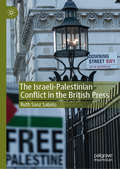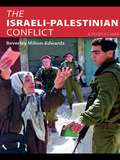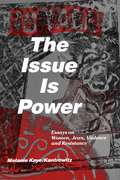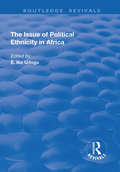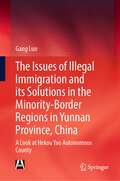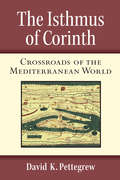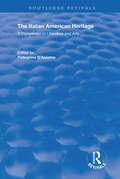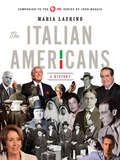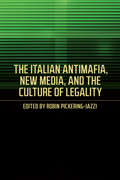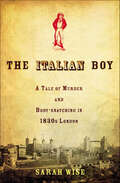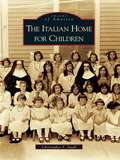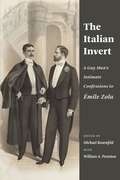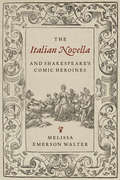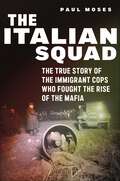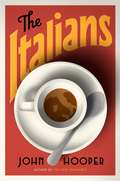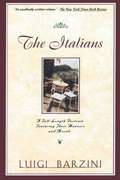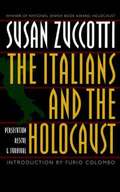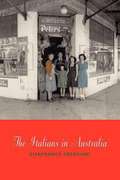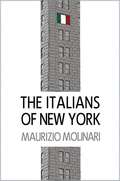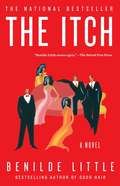- Table View
- List View
The Israeli-Palestinian Conflict in the British Press
by Ruth Sanz SabidoThe Israeli-Palestinian Conflict in the British Press provides an extensive empirical analysis of how the Israeli-Palestinian conflict has been constructed in British national newspapers since 1948. It traces the evolution of representations of the conflict by placing them in a historical context, with particular reference to Britain’s postcolonial relation to Palestine, and by presenting an in-depth analysis of the evolution of press language, including the use of terms such as ‘terrorism’ and ‘terrorist’ to classify agents of political violence. It applies an original approach to the study of media coverage, using a Postcolonial Critical Discourse Analysis framework, an innovative method that examines selected case studies in relation to theories of postcolonialism and discourse. Using this unique hybrid methodology, Sanz Sabido provides a thorough and precise unpicking of a highly mediated conflict.
The Israeli-Palestinian Conflict: A People's War
by Beverley Milton-EdwardsThe conflict between Israelis and Palestinians is one of the most enduring and complex in the modern world. But, why did the conflict break out? Who is demanding what, and why is peace so difficult to achieve? The Israeli-Palestinian Conflict tackles the subject and analyses the conflict from its historical roots in the late nineteenth century to the present attempts at conflict resolution in the twenty-first century. Framing the debate and analysis around issues such as Zionism, Palestinian nationalism, international peace efforts, the refugees, state-building, democracy and religious opposition and highlighted by first hand quotes and sources of the conflict from its major participants, Beverley Milton-Edwards explores the deep impact of the conflict on regional politics in the Middle East and why the enmity between Palestinians and Israelis has become a number one global issue drawing in the world’s most important global actors. An essential insight into the complexities of one of the world’s most enduring conflicts between Israelis and Palestinians, this textbook is designed to make a complex subject accessible to all. Key features include a chronology of events and annotated further reading at the end of each chapter. The Israeli-Palestinian Conflict is an ideal and authoritative introduction into aspects of politics in Israel, among the Palestinians – a vitally important issue for those studying the politics of the Middle East.
The Issue is Power: Essays on Women, Jews, Violence and Resistance
by Melanie Kaye KantrowitzPolitical activist and writer Melanie Kaye/Kantrowitzbrought an insightful eye and a sharp analytical mind to probe the problems facing America at the turn of the century. First published in 1992, the hard-hitting essays in this collection scan the connections across a wide range of issues: whether the topic is class, racism, Israel and Palestine, war, anti-Semitism, violence against women or violence by women, the issue is power—in all its complexity. Now in its second edition and no less relevant nearly three decades later, her work—dedicated, persistent—continues to remind us of the strength in community.“Beginning at the intersection of sex, race, class, ethnicity, and sexual orientation, Kaye/Kantrowitz asks hard questions in these essays about power, violence, resistance, and victimhood. ... At the core of The Issue Is Poweris a smart, engaged observer of the world who invites us to think and act with her.”—from the new foreword byJulie R. Enszer“Here is a book for everyone who dares to want to help make history. Melanie Kaye/Kantrowitzis passionate, strategic, pithy, generous, realistic, controversial, unquenchable—like the best of our movements for change. As a writer and lifelong doer, she gives us reasons to believe in achievable justice, and maps for acting on that belief.”—Adrienne Rich
The Issue of Political Ethnicity in Africa (Routledge Revivals)
by E. Ike UdoguThis title was first published in 2001. The central characteristics of political ethnicity and its dysfunctional attributes in African politics is vexing to Africa's policy makers. Moreover, as a conflictive ideology in national and international politics, many political actors would rather avoid it. In the past, nationalists have blamed ethnic chauvinists for fanning the embers of ethnicity, but today they realize they may have underestimated its prominence in African politics.
The Issues of Illegal Immigration and its Solutions in the Minority-Border Regions in Yunnan Province, China: A Look at Hekou Yao Autonomous County
by Gang LuoThis book analyzes the governance of illegal immigrants in ethnic areas along China’s southwest border. Since China is not an immigrant country and lacks an immigrant culture, the goals of law enforcement departments are limited to sanfeirenyuan (three types of illegal persons: illegal immigrants, illegal residents, and illegal employees). The transformation of sanfeirenyuan, an issue that has plagued China for many years, into an “illegal immigration” governance issue that is of general concern to the international community, has led to fundamental changes in research methods and research topics. The research presented here makes the issue China now faces part of global issues; by using the “worldview on China’s issues” to assess current problems, it can also show how “China’s solutions can be applied to global issues.” The unique feature of this book is that it approaches the issue of illegal immigration as an unconscious crisis. Accordingly, it holds substantial value in terms of exploring the theoretical basis of and governance methods for maintaining national security in the context of globalization, as well as the early warning mechanisms and crisis management in the context of China’s national security. Since China has a long southwest border, the stability and security of border ethnic areas have long played a decisive role in the stability and security of the country as a whole: if the frontiers are stable, the country enjoys enhanced security. Consequently, investigating the governance mechanism for illegal immigrants in the ethnic areas of the southwest border is of considerable practical relevance. This book offers a valuable asset for researchers in related fields and can be used as a reference book for students of national security. It also benefits practitioners in relevant management departments.
The Isthmus of Corinth: Crossroads of the Mediterranean World
by David Pettegrew"The narrow neck of Corinthian territory that joins the Peloponnese with the Greek mainland was central to the fortunes of the city of Corinth and the history of Greece in the Roman era. This situated Corinth well for monitoring land traffic both north and south, as between Athens and Sparta, and also sideways across the Isthmus, between the Gulf of Corinth to the west and the Aegean Sea to the east. David Pettegrew's new book investigates the Isthmus of Corinth from the Romans' initial presence in Greece during the Hellenistic era to the epic transformations of the Empire in late antiquity. A new interpretation of the extensive literary evidence outlines how the isthmus became the most famous land bridge of the ancient world, central to maritime interests of Corinth, and a medium for Rome's conquest, annexation, and administration in the Greek east. A fresh synthesis of archaeological evidence and the results of a recent intensive survey on the Isthmus describe the physical development of fortifications, settlements, harbors, roads, and sanctuaries in the region. The author includes chapters on the classical background of the concept isthmos, the sacking of Corinth and the defeat of the Achaean League, colonization in the Late Roman Republic, the Emperor Nero's canal project and its failure, and the shifting growth of the Roman settlement in the territory"--From publisher's website.
The Italian American Heritage: A Companion to Literature and Arts
by Pellegrino D’aciernoFirst published in 1999. The many available scholarly works on Italian-Americans are perhaps of little practical help to the undergraduate or high school student who needs background information when reading contemporary fiction with Italian characters, watching films that require a familiarity with Italian Americans, or looking at works of art that can be fully appreciated only if one understands Italian culture. This basic reference work for non-specialists and students offers quick insights and essential, easy-to-grasp information on Italian-American contributions to American art, music, literature, motion pictures and cultural life. This rich legacy is examined in a collection of original essays that include portrayals of Italian characters in the films of Francis Coppola, Italian American poetry, the art of Frank Stella, the music of Frank Zappa, a survey of Italian folk customs and an analysis of the evolution of Italian-American biography. Comprising 22 lengthy essays written specifically for this volume, the book identifies what is uniquely Italian in American life and examines how Italian customs, traditions, social mores and cultural antecedents have wrought their influence on the American character. Filled with insights, observations and ethnic facts and fictions, this volume should prove to be a valuable source of information for scholars, researchers and students interested in pinpointing and examining the cultural, intellectual and social influence of Italian immigrants and their successors.
The Italian American Table: Food, Family, and Community in New York City
by Simone CinottoBest Food Book of 2014 by The Atlantic Looking at the historic Italian American community of East Harlem in the 1920s and 30s, Simone Cinotto recreates the bustling world of Italian life in New York City and demonstrates how food was at the center of the lives of immigrants and their children. From generational conflicts resolved around the family table to a vibrant food-based economy of ethnic producers, importers, and restaurateurs, food was essential to the creation of an Italian American identity. Italian American foods offered not only sustenance but also powerful narratives of community and difference, tradition and innovation as immigrants made their way through a city divided by class conflict, ethnic hostility, and racialized inequalities. Drawing on a vast array of resources including fascinating, rarely explored primary documents and fresh approaches in the study of consumer culture, Cinotto argues that Italian immigrants created a distinctive culture of food as a symbolic response to the needs of immigrant life, from the struggle for personal and group identity to the pursuit of social and economic power. Adding a transnational dimension to the study of Italian American foodways, Cinotto recasts Italian American food culture as an American "invention" resonant with traces of tradition.
The Italian Americans: A History
by Maria LaurinoThis gorgeous companion book to the PBS series illuminates an important, overlooked part of American history. In this richly researched, beautifully designed and illustrated volume, Maria Laurino strips away stereotypes and nostalgia to tell the complicated, centuries-long story of the true Italian-American experience. Looking beyond the familiar Little Italys and stereotypes fostered by The Godfather and The Sopranos, Laurino reveals surprising, fascinating lives: Italian-Americans working on sugar-cane plantations in Louisiana to those who were lynched in New Orleans; the banker who helped rebuild San Francisco after the great earthquake; families interned as "enemy aliens" in World War II. From anarchist radicals to "Rosie the Riveter" to Nancy Pelosi, Andrew Cuomo, and Bill de Blasio; from traditional artisans to rebel songsters like Frank Sinatra, Dion, Madonna, and Lady Gaga, this book is both exploration and celebration of the rich legacy of Italian-American life. Readers can discover the history chronologically, chapter by chapter, or serendipitously by exploring the trove of supplemental materials. These include interviews, newspaper clippings, period documents, and photographs that bring the history to life.
The Italian Antimafia, New Media, and the Culture of Legality
by Robin Pickering-IazziThe past two decades have witnessed increasing opposition to mafia influence and activities in Italy. Community organizations such as Libera, founded in 1995, and Addiopizzo, originating in 2004, exemplify how Italian society has tried to come together to promote antimafia activities. The societal opposition to mafia influence continues to grow and the Internet has become a frontline in the battle between the two groups. The Italian Antimafia, New Media, and the Culture of Legality is the first book to examine the online battles between the mafia and its growing cohort of opponents. While the mafia’s supporters have used Internet technologies to expand its power, profits, and violence, antimafia citizens employ the same technologies to recreate Italian civil society. The contributors to this volume are experts in diverse fields and offer interdisciplinary studies of antimafia activism and legality in online journalism, Twitter, YouTube, digital storytelling, blogs, music, and photography. These examinations enable readers to understand the grassroots Italian cultural revolution, which makes individuals responsible for promoting justice, freedom, and dignity.
The Italian Boy: A Tale of Murder and Body-snatching in 1830s London
by Sarah WiseA thrilling history of England's great metropolis at a point of great change, told through the story of a young vagrant murdered by "resurrection men"Before his murder in 1831, the "Italian boy" was one of thousands of orphans on the streets of London, moving among the livestock, hawkers, and con men, begging for pennies. When his body was sold to a London medical college, the suppliers were arrested for murder. Their high-profile trial would unveil London's furtive trade in human corpses carried out by body-snatchers--or "resurrection men"--who killed to satisfy the first rule of the cadaver market: the fresher the body, the higher the price. Historian Sarah Wise reconstructs not only the boy's murder but the chaos and squalor of London that swallowed the fourteen-year-old vagrant long before his corpse appeared on the slab. In 1831, the city's poor were desperate and the wealthy were petrified, the population swelling so fast that old class borders could not possibly hold. All the while, early humanitarians were pushing legislation to protect the disenfranchised, the courts were establishing norms of punishment and execution, and doctors were pioneering the science of human anatomy. Vivid and intricate, The Italian Boy restores to history the lives of the very poorest Londoners and offers an unparalleled account of the sights, sounds, and smells of a city at the brink of a major transformation.
The Italian Diaspora in South Africa: Nostalgia, Identity, and Belonging in the Second and Third Generations (Routledge Studies in Development, Mobilities and Migration)
by Maria Chiara Marchetti-Mercer Anita VirgaThis book investigates the experiences of second- and third-generation Italians living in South Africa, exploring how nostalgia for Italy influences their sense of identity and belonging. The Italian community in South Africa is a unique diaspora, with a complex history, including roots in Italian colonial activities in Africa, and in World War II. This book looks at how the descendants of these early migrants take pride in being Italian and value the Italian language. They also ascribe much importance to their family roots, and have often created a romanticized image of Italy, mostly based on childhood vacation visits. The longing for an imaginary idealized version of Italy is closely linked to their wider search for a sense of identity and belonging against the backdrop of South African society, currently still grappling with its own multicultural identity. Interdisciplinary by design, this book draws on insights from both cultural studies and psychology in order to shine a light on an important and under-studied diasporic community. The book will be of interest to scholars from across migration studies and the Humanities in general.
The Italian Economy at the Dawn of the 21st Century
by Massimo Di Matteo and Paolo PiacentiniThis title was first published in 2003. Most of the essays collected in this volume are the revised versions of the reports presented at a conference held at the University of Tokyo in October 2001, organised as part of the initiatives of the "Italian Year" in Japan, and supported by the Foundation Italy in Japan 2001, the Italian Chamber of Commerce in Tokyo, the Italian Ministries of Foreign Affairs and of Higher Education, and the University of Tokyo. The essays, which aim at a fact-based presentation, provide a thorough survey of the relevant problems and aspects of present-day Italian economy and society. Those peculiar features of the Italian economy, such as its dualistic industrial structure and territorial divide, are analysed at length, with an eye to open policy options. The economic analyses are complemented by presentations of some of the central topics on the Italian social framework, such as the role of family and the "Third Sector".
The Italian Home for Children
by Christopher F. SmallAs it ravaged the world, the influenza epidemic of 1918 devastated Boston's congested North End and left hundreds of orphans in its wake. Touched by this crisis, a Roman Catholic priest and a group of Italian Americans founded the first home for Italian children in Massachusetts. Franciscan Sisters devoted 24 hours a day to providing the children with a safe, loving, and spiritual environment. In addition, the home provided educational support for its residents. Over time, the changing needs of children mandated that the agency change the nature of its services from custodial care to treatment. In 1974, in response to the changing political and social climate, the agency became the Italian Home for Children. Today, it is a nonprofit, nonsectarian residential treatment facility with a capacity for 61 children of all races, nationalities, and religions. The images in The Italian Home for Children document milestones in the organization's history: the devastating influenza epidemic, the Missionary Franciscan Sisters of the Immaculate Conception, Christmas plays, a visit from Joe DiMaggio, trips to Canobie Lake Park in the summer, the Tony Martin benefit performance at Boston Garden, and the home as it is today--a refuge for children in the most severe crises.
The Italian Invert: A Gay Man’s Intimate Confessions to Émile Zola
by with William A. Peniston“Each of us has his tastes inscribed in his brain and heart; whether he fulfills his urges with regret or with joy, he must fulfill them. He should let others act according to their own nature. It’s fate that creates us and guides us throughout our lives: to fight against it would be little more than fruitless, foolish, and reckless!”In the late 1880s, a dashing young Italian aristocrat made an astonishing confession to the novelist Émile Zola. In a series of revealing letters, he frankly described his sexual experiences with other men—including his seduction as a teenager by one of his father’s friends and his first love affair, with a sergeant during his military service—as well as his “extraordinary” personality. Judging it too controversial, Zola gave it to a young doctor, who in 1896 published a censored version in a medical study on sexual inversion, as homosexuality was then known. When the Italian came across this book, he was shocked to discover how his life story had been distorted. In protest, he wrote a long, daring, and unapologetic letter to the doctor defending his right to love and to live as he wished.This book is the first complete, unexpurgated version in English of this remarkable queer autobiography. Its text is based on the recently discovered manuscript of the Italian’s letter to the doctor. It also features an introduction tracing the textual history of the documents, analytical essays, and additional materials that help place the work in its historical context. Offering a striking glimpse of gay life in Europe in the late nineteenth century, The Italian Invert brings to light the powerful voice of a young man who forthrightly expressed his desires and eloquently affirmed his right to pleasure.
The Italian Novella and Shakespeare’s Comic Heroines
by Melissa WalterUsing a comparative, feminist approach informed by English and Italian literary and theatre studies, this book investigates connections between Shakespearean comedy and the Italian novella tradition. Shakespeare’s comedies adapted the styles of wit, character types, motifs, plots, and other narrative elements of the novella tradition for the Elizabethan and Jacobean stage, and they investigated social norms and roles through a conversation carried out in narrative and drama. Arguing that Shakespeare’s comedies register the playwright’s reading of the novella tradition within the collaborative playmaking context of the early modern theatre, this book demonstrates how the comic vision of these plays increasingly valued women’s authority and consent in the comic conclusion. The representation of female characters in novella collections is complex and paradoxical, as the stories portray women not only in the roles of witty plotters and storytellers but also through a multifaceted poetics of enclosed spaces – including trunks, chests, caskets, graves, cups, and beds. The relatively open-ended rhetorical situation of early modern English theatre and the dialogic form and narrative material available in the novella tradition combine to help create the complex female characters in Shakespeare’s plays and a new form of English comedy.
The Italian Squad: The True Story of the Immigrant Cops Who Fought the Rise of the Mafia
by Paul MosesThe unknown inside story of the NYPD’s Italian-born detectives who fought both powerful gangsters and the deeply ingrained prejudice against their own beloved immigrant communityThe story begins in Sicily, on Friday, March 12, 1909, at 8:45 p.m. Three gunshots thundered in the night, and then a fourth. Two men fled, and investigators soon discovered who they had killed: Giuseppe Petrosino, the legendary American detective whose exploits in New York were celebrated even in Italy.The Italian Squad, by veteran New York City journalist and historian Paul Moses, explores the lives of the nationally celebrated detectives who followed in the slain Petrosino’s footsteps as leaders of the New York City investigative squad: Anthony Vachris, Charles Corrao, and Michael Fiaschetti. Drawing on new primary sources such as private diaries and city, state, and federal documents, this dramatic narrative history follows the Italian Squad across the first two decades of the twentieth century as its detectives battled increasingly powerful gangsters, political obstacles and deeply ingrained prejudice against their own beloved Italian immigrant community.Vachris, Corrao, and Fiaschetti became, like Petrosino, famous for meting out tough justice to criminals who comprised the “Black Hand.” Beyond trying to prevent horrific crimes—nighttime bombings in crowded tenements, kidnappings that targeted children at play, gangland shootings that killed innocent bystanders—the Italian Squad commanders hoped to persuade society of what they knew for themselves: that their fellow immigrant Italians, so often maligned, would make good American citizens.In this explosive story, Moses carefully strips away the mythology that has always enveloped the Italian Squad and offers instead a nuanced portrait of brave but flawed men who fought the good fight for their people and their city.
The Italian Urban System: Towards European Integration (Routledge Revivals)
by Piero Bonavero Giuseppe Dematteis Fabio SforziFirst published in 1999, this volume situates the Italian urban system within a European context, examining the best approach to integration. Connections between urban development, territorial cohesion and the European urban system have been clearly identified by Europe 2000 (1991) and identified as primary instruments for achieving social and economic cohesion and competitiveness as per the Treaty of Maastricht and the White Paper, Growth, Competitiveness, Employment (1993). This book aids this endeavour through featuring contributions on cities as nodes of transport networks, economic change, the demographic transition, the local milieu, regional cohesion and global networks and how the system can integrate into European urban networks.
The Italians
by John HooperA vivid and surprising portrait of the Italian people from an admired foreign correspondentHow can a nation that spawned the Renaissance have produced the Mafia? How could people concerned with bella figura (keeping up appearances) have elected Silvio Berlusconi as their leader--not once, but three times? Sublime and maddening, fascinating yet baffling, Italy is a country of seemingly unsolvable riddles.John Hooper's entertaining and perceptive new book is the ideal companion for anyone seeking to understand contemporary Italy and the unique character of the Italians. Digging deep into their history, culture, and religion, Hooper offers keys to understanding everything from their bewildering politics to their love of life and beauty. Looking at the facts that lie behind the stereotypes, he sheds new light on many aspects of Italian life: football and Freemasonry, sex, symbolism, and the reason why Italian has twelve words for a coat hanger, yet none for a hangover.Even readers who think they know Italy well will be surprised, challenged, and delighted by The Italians.
The Italians
by Luigi BarziniIn this consummate portrait of the Italian people, Luigi Barzini delves deeply into the Italian national character, discovering both its great qualities and its imperfections.
The Italians and the Holocaust: Persecution, Rescue, and Survival
by Susan ZuccottiEighty-five percent of Italy's Jews survived World War II. <P><P>Nevertheless, more than six thousand Italian Jews were destroyed in the Holocaust and the lives of countless others were marked by terror. <P><P>For Zuccotti, the Holocaust in Italy began when the first "black-shirted thug" poured a bottle of castor oil down the throat of his victim, or when the dignity of a single human being was violated. <P><P>Susan Zuccotti relates hundreds of stories showing the resourcefulness of the Jews, the bravery of those who helped them, and the inhumanity and indifference of others.
The Italians in Australia
by Gianfranco CrescianiGianfranco Cresciani's authoritative account of their significant contributions to the development of Australian society through the twentieth century is comprehensive. As an authority on Italian life in Australia, Cresciani provides a definitive account of the Italo-Australian community entering the twenty-first century.
The Italians of New York
by Maurizio MolinariAn overview of generations of Italians in the Big Apple, weaving together numerous stories from different epochs and different backgrounds. "If you want to learn something about Italian creativity, come to New York. Here, you will find the pride of flying the Italian colors at the Fifth Avenue Columbus Day Parade, the American patriotism of those who perished at Ground Zero, the courage of firefighters and marines on the frontline of the war against terrorism, the babel of dialects at the Arthur Avenue market, portrayals of social change in the writings of Gay Talese, stories of successful business ventures on the TV shows of Maria Bartiromo and Charles Gasparino, political passion in the battles of Mario Cuomo and Rudy Giuliani, creative imagination in the works of Gaetano Pesce, Renzo Piano and Matteo Pericoli, and provocation in the attire of Lady Gaga... The Midtown top managers, whoarrived in the past twenty years, operate in the XXI century, while on Fresh Pond Road in Ridgewood the panelle are still prepared according to the Sicilian recipes transmitted from one generation to the next." (From the "Introduction")
The Italic People of Ancient Apulia
by T. H. Carpenter K. M. Lynch E. G. D. Robinson T. H. Carpenter K. M. LynchThe focus of this book is on the Italic people of Apulia during the fourth century BC, when Italic culture seems to have reached its peak of affluence. Scholars have largely ignored these people and the region they inhabited. During the past several decades archaeologists have made significant progress in revealing the cultures of Apulia through excavations of habitation sites and un-plundered tombs, often published in Italian journals. This book makes the broad range of recent scholarship - from new excavations and contexts to archaeometric testing of production hypotheses to archaeological evidence for reconsidering painter attributions - available to English-speaking audiences. In it thirteen scholars from Italy, the United States, Great Britain, France, and Australia present targeted essays on aspects of the cultures of the Italic people of Apulia during the fourth century BC and the surrounding decades.
The Itch
by Benilde LittleFrom the author of the smashing debut bestseller Good Hair comes The Itch, the stirring story of a crisis-torn woman who discovers a depth of character and a sense of self she never knew she possessed.Abra Lewis Dixon is the envy of the fashionable, professional women of her well-heeled social circle. She leads a charmed life -- having attended all the right schools, married the right man, and started a successful film production company with her best friend, Natasha Coleman -- and seems like an ambassador from the world of perfection. It is only when her impeccable marriage turns suddenly shaky that her utopia is left in pieces.
